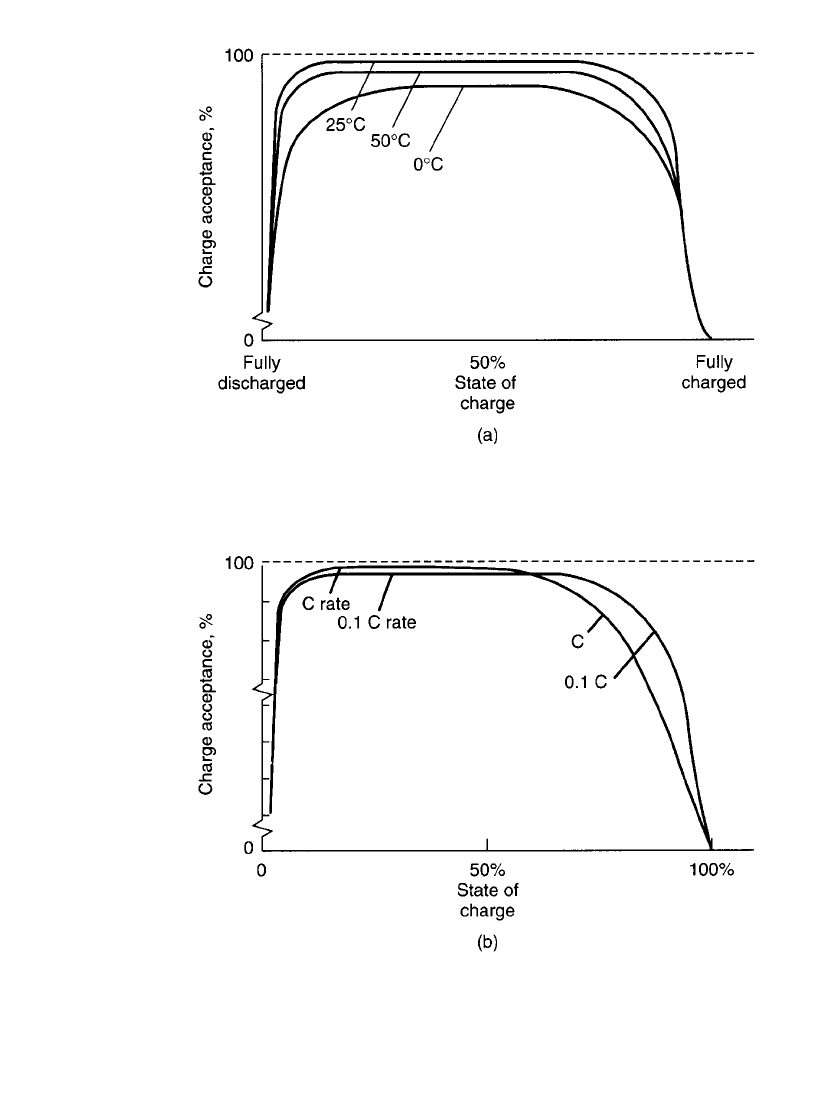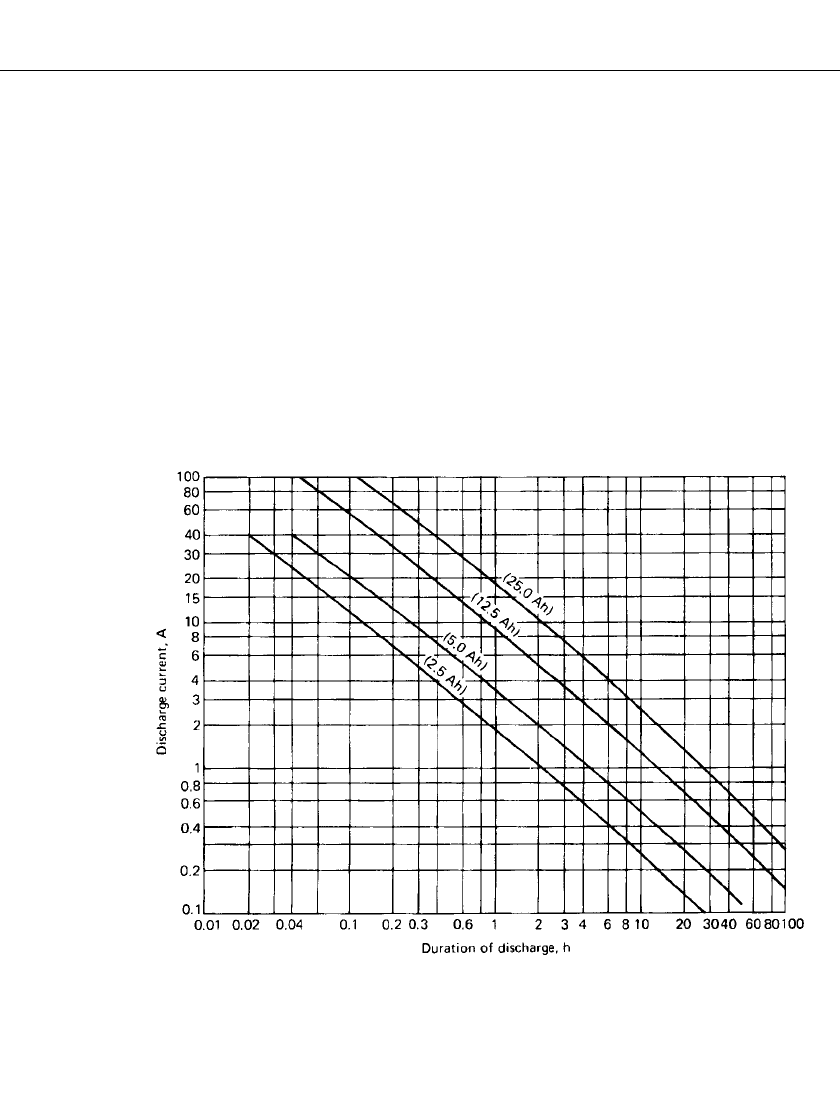Linden D., Reddy T.B. (eds.) Handbook of batteries
Подождите немного. Документ загружается.


24.38 CHAPTER TWENTY-FOUR
FIGURE 24.46 Charge acceptance of sealed lead-acid batteries. (a) At various tem-
peratures. (b) At various charge rates.

VALVE REGULATED LEAD-ACID BATTERIES 24.39
24.6 SAFETY AND HANDLING
Two primary considerations relative to the application of VRLA batteries should be recog-
nized to ensure that their usage is safe and proper: gassing and short-circuiting.
24.6.1 Gassing
Lead-acid batteries produce hydrogen and oxygen gases internally during charging and over-
charging. These gases are released in an explosive mixture from conventional lead-acid
batteries and therefore must not be allowed to accumulate in a confined space. An explosion
could occur if a spark were introduced.
The VRLA battery, however, operates on 100% recombination of the oxygen gas produced
at recommended rates of charging and overcharging, and so there is no oxygen outgassing.
During normal operation, some hydrogen gas and also some carbon dioxide gas are given
off. The hydrogen outgassing is essential with each cycle to ensure continued internal chem-
ical balance. The lead grid construction of the VRLA battery minimizes the amount of
hydrogen gas produced. Carbon dioxide is produced by oxidation of organic compounds in
the cell.
The minute quantities of gases which are released from the VRLA battery with recom-
mended rates of charge and overcharge will normally dissipate rapidly into the atmosphere.
Hydrogen gas is difficult to contain in anything but a metal or glass enclosure, that is, it can
permeate a plastic container at a relatively rapid rate. Because of the characteristics of gases
and the relative difficulty in containing them, most applications will allow for their release
into the atmosphere. However, if the VRLA battery is being designed into a gastight con-
tainer, precautions must be taken so that the gases produced can be released to the atmo-
sphere. If hydrogen is allowed to accumulate and mix with the atmosphere at a concentration
of between 4 and 79% (by volume at standard temperature and pressure), an explosive
mixture would be present which would be ignited in the presence of a spark or flame.
Another consideration is the potential failure of the charger. If the charger malfunctions,
causing higher-than-recommended charge rates, substantial volumes of hydrogen and oxygen
will be vented from the battery. This mixture is explosive and should not be allowed to
accumulate. Adequate ventilation is required. Therefore the VRLA battery should never be
operated in a gastight container. The batteries should never be totally encased in a potting
compound since this prevents the proper operation of the venting mechanism and free release
of gas. Furthermore, considerable pressure can build up in a gas-tight container. This can
occur during storage because of the continuous generation of carbon dioxide gas. Such
pressure is further compounded during charging by the generation of hydrogen.
24.6.2 Short-circuiting
These batteries have low internal impedance and thus are capable of delivering high currents
if externally short-circuited. The resultant heat can cause severe burns and is a potential fire
hazard. Particular caution should be used when any person working near the open terminals
of cells or batteries is wearing metal rings or watchbands. Inadvertently placing these metal
articles or tools across the terminals could result in severe skin burns.

24.40 CHAPTER TWENTY-FOUR
24.7 BATTERY TYPES AND SIZES
A listing of VRLA cylindrical batteries is given in Table 24.2. The performance of these
units at various current drains at 25
⬚C is given in Fig. 24.47. A number of multicell batteries
are available that use these cells in various series/parallel configurations.
Table 24.3 and 24.4 list some of the typical VRLA prismatic lead-acid batteries that are
manufactured. Information on other manufacturers’ products can be obtained by consulting
their websites, such as yuasastationary.com, panasonic.com and www.hoppecke.com. Unlike
some of the other types of lead acid batteries, there is no standardized list of sizes. Hence
sizes, weights, and capacity ratings may vary from manufacturer to manufacturer.
Table 24.5 lists some of the thin prismatic VRLA batteries. These are generally used in
multicell battery packs which can be built in a variety of configurations, depending on the
equipment requirements. Typical discharge performance characteristics are shown in Fig.
24.30.
FIGURE 24.47 Discharge times of four types of VRLA cylindrical batteries at 25⬚C.

24.41
TABLE 24.3 Specifications for Typical VRLA Lead-Calcium Batteries
LS 12-25 LS 6-50 LS 12-55 LS 12-80 LS 12-100 LS 6-125 LS 6-200 LS 4-300 LS 2-600
Nominal voltage 12 volts 6 volts 12 volts 12 volts 12 volts 6 volts 6 volts 4 volts 2 volts
Number of cells 6 / unit 3 / unit 6 / unit 6 / unit 6 / unit 3 / unit 3 / unit 2 / unit 1 / unit
Rated 8-hr
capacity
(Ampere-hours
to 1.75 Vpc)
25 Ah to
10.5 volts
50 Ah to
5.25 volts
52 Ah to 10.5
volts
80 Ah to 10.5
volts
100 Ah to 10.5
volts
123 Ah to 1.75
volts
200 Ah
to 5.25
volts
300 Ah to 3.5
volts
600 Ah to 1.75
volts
Rated 15-min
capacity
(kiloWatts to
1.67 Vpc) per
cell
0.092 0.185 0.172 0.275 0.344 0.430 0.688 1.032 2.063
Internal
resistance per
cell
0.10
Ohms
0.003
Ohms
0.00157 Ohms 0.00094 Ohms 0.000786 Ohms 0.00062 Ohms 0.000393
Ohms
0.000262
Ohms
0.000131
Ohms
Short circuit
current
1155 A 2310 A 1274 A 2128 A 2545 A 3180 A 5089 A 7634 A 15267 A
Unit height 7.11 in
(181
mm)
7.11 in
(181
mm)
9.20 in (234
mm)
9.20 in (234 mm) 9.20 in* (234
mm)
9.95 in (253
mm)
9.20 in*
(234
mm)
9.20 in* (234
mm)
9.20 in* (234
mm)
Unit length
(includes
handles)
7.64 in
(194
mm)
7.64 in
(194
mm)
10.20 in (259
mm)
13.94 in (354 mm) 16.58 in (421
mm)
16.60 in (422
mm)
16.58 in
(421
mm)
16.58 in (421
mm)
16.58 in (421
mm)
Unit width 5.20 in
(132
mm)
5.20 in
(132
mm)
6.80 in (173
mm)
6.80 in (173 mm) 6.84 in (174
mm)
3.40 in (86
mm)
6.84 in
(174
mm)
6.84 in (174
mm)
6.84 in (174
mm)
Weight 23 lbs (10 kg) 56 lbs (25 kg) 79 lbs (36 kg) 95 lbs (43 kg) 59 lbs (27 kg) 95 lbs (43 kg)
Plate thickness
positive negative
0.124 in (3.15 mm)
0.065 in (1.65 mm)
0.140 in (3.56 mm)
0.085 in (2.16 mm)
0.150 in (3.81
mm)
0.080 in (2.03
mm)
0.140 in (3.56 mm)
0.085 in (2.16 mm)
Terminal
characteristics
0.55 in diameter, threaded-brass insert, 0.50
in deep. Fasten with 10-32 stainless steel
hex bolt / washer.
1.00 in diameter, threaded copper-brass
insert, 0.75 in deep. Fasten with 1/4-20
stainless steel hex bolt / washer.
0.65 mm in
diameter,
threaded-brass
insert,
0.50 in deep.
Fasten with
1/4-20 stainless
steel hex bolt /
washer.
1.00 in diameter, theaded copper-brass insert,
0.75 in deep. Fasten with 1/4-20 stainless steel
hex bolt / washer.
Source: C and D Technologies Product Brochure 12-373. See website:cdpowercom.com.

24.42 CHAPTER TWENTY-FOUR
TABLE 24.4 Specifications for Typical Pure Lead-Tin VRLA Batteries
Product
(capacity)
Internal res. of
fully charged
battery m
⍀ @25⬚C
Nominal short
circuit current
for charged
battery
Dimensions
Length
in.
(mm)
Width
in.
(mm)
Height
in.
(mm)
Weight
lb.
(kg)
G13EP
(13Ah)
8.5 1,400A 6.910
(175.51)
3.282
(83.36)
5.113
(129.87)
10.8
(4.9)
G13EPX
(13Ah)
8.5 1,400A 6.998
(177.75)
3.368
(85.55)
5.165
(131.19)
12.0
(5.4)
G16EP
(16Ah)
7.5 1,600A 7.150
(181.61)
3.005
(76.33)
6.605
(167.77)
35.5
(6.1)
G16EPX
(16Ah)
7.5 1,600A 7.267
(184.58)
3.107
(78.92)
6.666
(169.32)
14.7
(6.7)
G26EP
(26Ah)
5.0 2,400A 6.565
(166.75)
6.920
(175.77)
4.957
(125.91)
22.3
(10.1)
G26EPX
(26Ah)
5.0 2,400A 6.636
(168.55)
7.049
(179.04)
5.040
(128.02)
23.8
(10.8)
G42EP
(42Ah)
4.5 2,600A 7.775
(197.49)
6.525
(165.74)
6.715
(170.56)
32.9
(14.9)
G42EPX
(42Ah)
4.5 2,600A 7.866
(199.80)
6.659
(169.14)
6.803
(172.80)
35.1
(15.9)
G70EP
(70Ah)
3.5 3,500A 13.020
(330.71)
6.620
(168.15)
6.930
(176.02)
53.5
(24.3)
G70EPX
(70Ah)
3.5 3,500A 13.020
(330.71)
6.620
(168.15)
6.930
(176.02)
56.0
(25.4)
G26VP
(26Ah)
5.0 2,400A 6.565
(166.75)
6.920
(175.77)
4.957
(125.91)
22.3
(10.1)
G26VPX
(26Ah)
5.0 2,400A 6.636
(168.55)
7.049
(179.04)
5.040
(128.02)
23.8
(10.8)
G42VP
(42Ah)
4.5 2,600A 7.775
(197.49)
6.525
(165.74)
6.715
(170.56)
32.9
(14.9)
G42VPX
(42Ah)
4.5 2,600A 7.866
(199.80)
6.559
(169.14)
6.803
(172.80)
35.1
(15.9)
Source: Hawker Energy Products, Inc. Brochure. See website:www.hawker.invensys.com.
TABLE 24.5 Thin VRLA Prismatic Batteries
Capacity, Ah
C /10 C /20 1C
Dimensions, mm
Thickness Width Length
Weight
(typical),
g
Specific
Energy
Wh/ Kg
Energy
Density
Wh/L
1.40
1.80
1.46
1.88
3.0
5.0
1.02
1.31
1.9
3.2
8.7
8.7
8.4
8.4
33.0
41.7
66.5
79.2
97
97
99.3
135.1
90
115
140
226
32.4
32.6
42.8
44.2
105.0
107.0
108.0
111.0
Source: Top two batteries: Panasonic, Division of Matsushita Electric Corp. of America (see: panasonic.com). Bottom two batteries:
Portable Energy Products, Inc.

VALVE REGULATED LEAD-ACID BATTERIES 24.43
24.8 APPLICATIONS OF VRLA BATTERIES TO UNINTERRUPTIBLE
POWER SUPPLIES
The major application of the VRLA battery is in the standby power market, ranging from
low-power (generally less than 5 KVA) applications such as emergency lighting or uninter-
ruptible power supplies (UPSs) for individual computers or work stations to high-power UPSs
in telecommunications facilities. A continuous supply of power is also critical in areas such
as banking, stock exchanges, hospitals, air traffic control centers etc., where brief interrup-
tions pose the risk of loss of critical data or hazards to health and safety. The low-power
UPS systems are generally used where a power loss is acceptable as long as there is sufficient
power to allow time for a safe shutdown of equipment. In a high-power application, the UPS
is typically required to provide power until a generator can be brought on line.
UPS systems are generally one of three basic designs: (1) standby or off-line; (2) on-line;
or (3) line interactive/hybrid. In most UPSs, AC power is fed to a battery charger/ rectifier
to provide the DC power to float charge the battery. The output of the battery is connected
to an inverter that converts the DC output of the battery and /or the battery charger/rectifier
to provide AC power needed to run the load. In the standby mode off-line UPS system, the
battery and inverter only come into play when the normal AC power fails. In the on-line
UPS system, the battery and inverter are always in the circuit. When the AC power fails,
the battery is already on-line supplying power to the inverter and no voltage dropout occurs,
as opposed to the off-line case where the voltage may drop out, typically for milliseconds
before the battery/inverter duo is switched into service. The on-line UPS system serves also
to smooth out any voltage fluctuations with the battery/inverter a continuously active element
in the circuit (see Sec. 23.9.6). The line interactive hybrid UPS system utilizes an automatic
voltage regulator and a special transformer to smooth any under- or over-voltages and to
ease the transition to complete battery backup only during outages of the input AC power.
A comprehensive treatment of UPS systems, markets and alternative UPS systems (e.g.,
flywheels) is given in Ref 18.
The experiences with VRLA batteries in the high-power UPS arena have served to dem-
onstrate the complex problems associated with these batteries compared to their flooded
counterparts. For most of the 20th century, lead-acid batteries for high-power UPS systems,
notably those employed in telecommunications facilities, were of the flooded type. Flooded
batteries have relatively large footprints, can spill acid and require periodic maintenance in
the form of watering, a costly operation for a UPS facility involving a large number of cells.
In the mid 1980s, with the advent of the VRLA battery and its maintenance-free feature,
there was immediate interest in replacing flooded with VRLA batteries. Initially, expectations
were that VRLA batteries would provide the roughly 20-year life found with flooded bat-
teries. Failures of VRLA batteries occurred after only a few years of service in many cases.
One unanticipated problem, negative plate self-discharge is considered below. In the year
2000, more realistic claims of 5–10 year battery life were the rule and there was a trend
back to flooded lead-acid for the high-power UPS applications. Some switching from lead-
acid to nickel-cadmium or nickel-metal hydride batteries for low-power UPS applications is
also taking place or being considered.
The life of a VRLA battery in a UPS application depends not only on the design of the
battery and the quality of its manufacture, but also very strongly on the usage. Most of the
performance figures quoted in the manufacturers’ specifications are for operating tempera-
tures of 25
⬚C. Any significant deviation from that temperature, higher or lower, can result
in poor performance, especially in the hands of a customer without knowledge of the proper
handling of VRLA batteries. For example, the optimal charging regime for a VRLA battery
is quite dependent on the temperature and must be modified for either higher or lower
temperatures (see Sec. 24.5.4). VRLA batteries that perform perfectly well in a constant
temperature environment may perform quite poorly, even exploding or catching fire, in an
outdoor cabinet in a telecommunications application in a variable climate.

24.44 CHAPTER TWENTY-FOUR
There is, however, a considerable amount of research going into various ways to improve
VRLA technology to overcome some of its deficiencies. These deficiencies are related gen-
erally to the oxygen recombination feature of the VRLA battery. One problem is negative
plate self-discharge, a problem which has been found even in batteries that have been op-
erated under conditions conforming to the battery manufacturers’ recommendations. This
negative self-discharge leads to the negative being in a significantly reduced state of charge
and a reduced battery capacity results. In flooded batteries, the float current is more than
ample to keep the negative plate fully charged. In VRLA batteries this is not necessarily the
case and at least three approaches have been suggested for improving the situation. One is
to increase the purity of the negative plate. Certain impurities tend to lower the overvoltage
for hydrogen evolution. A second approach is to increase the corrosion rate of the positive
grid, not an attractive alternative for long-life batteries. Another approach is the addition of
a catalyst to promote the recombination of hydrogen and oxygen.
19
This catalytic approach
should compensate for impure active materials as well as for air leaks into the cell. The
addition of a catalyst may also increase the negative polarization, thus lowering the positive
polarization, which in turn would lessen positive grid corrosion. A combination of higher
purity negative plates and a catalyst could be an even better solution to negative plate po-
larization but the purity problem is complicated by the desire to use recycled lead, with
attendant needs for improved refining processes. One company is manufacturing catalytic
devices for use in new batteries or in some cases, retrofitting batteries already in service.
Whether any of the above remedies would resolve the safety issues associated with ther-
mal runaway, especially under conditions of operation and improper charging outside rec-
ommended temperature limits remains an open question. An overview of the controversies
that have surrounded VRLA batteries and their performance can be gleaned from proceedings
of recent INTELEC conferences.
19
VRLA batteries with catalysts and other improvements
have not yet been in the field long enough to determine whether the newer designs and
additions will indeed prove the solutions to some of the VRLA problems. Controversy is
still rampant over the current and future prospects for VRLA batteries in UPS applications.
Data on two examples of VRLA batteries now available are given in Tables 24.6a, b and
c. These cells employ lead-calcium-tin positive grids and lead-calcium negative grids, a self-
resealing safety vent releasing at 2 psi. Lead-calcium alloy grids are also used by other
manufacturers. Batteries are floated at 2.23 to 2.35 volts per cell at 25
⬚C.
The discharge rate data for a small 6-cell 12 V, 25 Ah (at C /8 to 10.5 V) VRLA battery
are presented in Table 24.7. The dimensions of this battery are: height 181 mm; width 132
mm; length 194 mm with a weight of 10 kg.
The discharge rate data are presented in Table 24.8 for a 8 volt, 427 kg, 1360 Ah battery
model #4DDV85-33 manufactured by Enersys, Inc.
The above data are for randomly selected batteries out of many marketed for UPS ap-
plications, and are believed to be representative of the products currently on the market for
UPS applications.
TABLE 24.6a Prismatic VRLA Sincle-cell Battery Characteristics at 25⬚C
Voltage Capacity, Ah Height, mm Width, mm Length, mm Weight, kg
Max.
amps*
2 V /cell 500 (C / 8)
346 (C /2)
368 182 228 32 1000
2 V /cell 1440 (C / 8)
968 (C /2)
580 328 183 88 2880
* Maximum current for 1 minute duration.
Source: Panasonic Website: www.panasonic.com.

VALVE REGULATED LEAD-ACID BATTERIES 24.45
TABLE 24.6b Self-discharge Data for Cells in Table 24.6(a) at 25⬚C
Storage time 3 months 6 months 12 months 18 months
% Initial Capacity 91 82 64 50
TABLE 25.6c Discharge Rate (Amperes) for
1440 Ah Battery in Table 24.6(a)
Hours 20 10 8 4 1
Cut-off voltage:
1.60
1.75
1.90
76
72
64
151
143
128
187
180
151
319
300
259
894
731
540
TABLE 24.7 Discharge Rate (Amps) for Six-cell, 25 Ah Battery
Time 20 h 10 h 30 min 10 min 1 min
Cut-off voltage:
1.75 V
1.90 V
1.4
1.2
2.6
2.2
28.4
22.4
57.2
39.8
113.1
57.9
Source: C&D Technologies Web site: www.cdpowercom.com
TABLE 24.8 Discharge Rate (Amps) for 8 Volt, 1360 Ah Battery
Time 24 h 10 h 1 h 15 min 1 min
Cut-off voltage:
1.75 V /cell 61 145 672 1248 1472
Source: Enersys, Inc.

24.46 CHAPTER TWENTY-FOUR
REFERENCES
1. S. Takahashi, K. Hirakawa, M. Morimitsu, Y. Yamagachi, and Y. Nakayama, ‘‘Development of a
Long Life VRLA Battery for Load Leveling-2,’’ Yuasa-JIHO, No. 88, p. 34–38, April 2000.
2. A. G. Cannone, A. J. Salkind, and F. A. Trumbore. Proc. 13th Annual Battery Conf. Long Beach,
CA, Jan. 1998.
3. M. Pavlov, Conference on Oxygen Cycle in Lead- Acid Batteries, 7th ELBC, Dublin, Ireland, 19
September 2000.
4. D. Berndt, ‘‘Valve-Regulated Lead-Acid Battery,’’ and ‘‘Lead-Acid Batteries.’’ (Conference on Ox-
ygen Cycle in Lead and Batteries, 7th ELBC, Dublin, Ireland (Sept. 2000)
5. P. Moseley, ‘‘Improving the Valve Regulated Lead-Acid Battery,’’ Proc. 1999 IBMA Conf., Battery
Man, Feb. 2000, p. 16–29.
6. W. W. McGill III, ‘‘Gel vs. VRLA Lift Truck Batteries,’’ Battery Man, Feb. 2000, p. 34–36.
7. D. H. McClelland et al., U.S. Patent 3,704,173 and U.S. Patent 3,862,861.
8. Bolder Battery Co. Literature, Bolder, CO.
9. T. B. Atwater, L. P. Jarvis, P. J. Cygun, and A. J. Salkind, 7th ELBC, Dublin, Ireland (2000).
10. Sealed Lead-Acid Batteries Technical Handbook, Panasonic Industrial Co., Secaucus, N.J.
11. G. A. Moneypenny, ‘‘Thinline Batteries for Portable Applications,’’ Proc. 11th Int. Seminar on
Batteries, Boca Raton, Fla., March 1994.
12. K. R. Bullock and D. H. McClelland, ‘‘The Kinetics of the Self-Discharge Reaction in a Sealed
Lead-Acid Cell.’’ J. Electrochem. Soc. 123:327 (Mar. 1976).
13. J. Arias, ‘‘Advanced Bipolar Lead-Acid Batteries,’’ Proc. 11th Int. Seminar on Batteries, Boca Raton,
Fla., March 1994 and T. Juergens et al., ‘‘A New Sealed High-Power Lead-Acid Battery.’’ Proc. 11
th
Int. Seminar on Batteries, Boca Raton, FL, March, 1994.
14. T. Juergens et al., ‘‘A New High Rate Sealed Lead-Acid Battery,’’ Proc. 36th Power Sources Conf.,
Cherry Hill, N.J., June 1994.
15. R. O. Hammel, ‘‘Charging Sealed Lead Acid Batteries,’’ Proc 27th Annual Power Sources Symp.,
1976.
16. W. Jones and D. O. Feder, Batteries International, pp. 77–83 (1997).
17. R. O. Hammel, ‘‘Fast Charging Sealed Lead Acid Batteries,’’ extended abstracts, pp. 34–36, Elec-
trochem. Soc. Meeting, Las Vegas, Nev., 1976.
18. J. Plante in Power 2000, pp. 30–94 (Supplement to EE Times (2000)).
19. E. Jones, INTELEC 2000.

25.1
CHAPTER 25
IRON ELECTRODE BATTERIES
John F. Jackovitz and Gary A. Bayles*
25.1 GENERAL CHARACTERISTICS
Iron electrodes have been used as anodes in rechargeable battery systems since the intro-
duction of the nickel-iron rechargeable battery at the turn of the century by Junger in Europe
and Edison in the United States.
1
Even today the batteries are produced in a fashion similar
to the original construction. New constructions have been developed which give better high-
rate performance and have lower manufacturing costs. Today the nickel-iron battery is the
most common rechargeable system using iron electrodes. Iron-silver batteries have been
tested in special electronic applications, and iron/ air batteries have shown promise as motive
power systems. The characteristics of the iron battery systems are summarized in Tables
25.1 and 25.2.
As designed by Edison, the nickel-iron battery was and is almost indestructible. It has a
very rugged physical structure and can withstand electrical abuse such as overcharge, over-
discharge, discharged stand for extended periods, and short-circuiting. The battery is best
applied where high cycle life at repeated deep discharges is required (such as traction ap-
plications) and as a standby power source with a 10- to 20-year life. Its limitations are low
power density, poor low-temperature performance, poor charge retention, and gas evolution
on stand. The cost of the nickel-iron battery lies between the lower-cost lead-acid and the
higher-cost nickel-cadmium battery in most applications, with the exception of limited use
applications in electric vehicles and mobile industrial equipment.
Most recently, iron electrodes have been considered and tested as cathodes too. Based
upon high valence state iron, Fe(VI), these cathodes have shown promise in experimental
cells when coupled with zinc or metal hydride anodes for portable primary and secondary
batteries. The results are discussed in Sec. 25.7.
*Ralph J. Brodd was the original author for this chapter.
